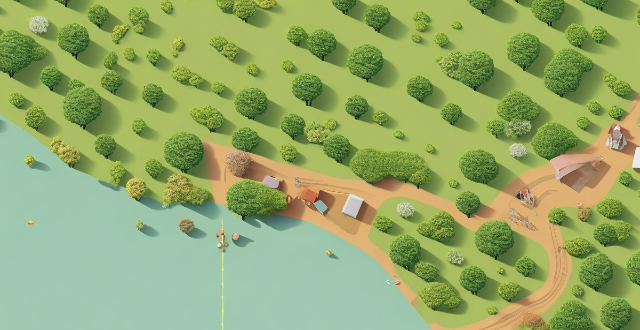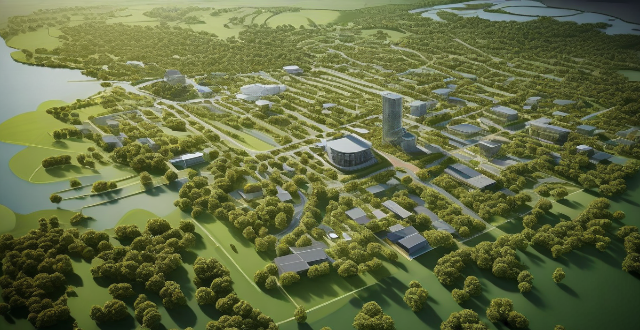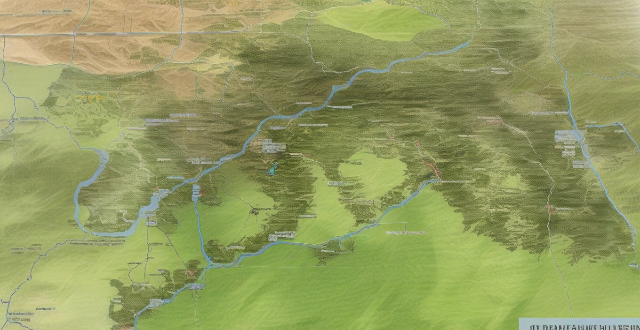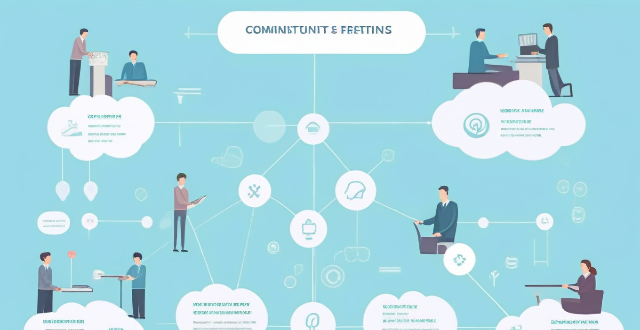Social Adaptation

What is the relationship between social inequality and access to resources for climate adaptation ?
The relationship between social inequality and access to resources for climate adaptation is influenced by economic, social, and political factors. Wealthier individuals often have more resources, while marginalized groups may face discrimination. Education plays a crucial role in raising awareness about climate change, and cultural beliefs can impact adaptation strategies. Government policies can either exacerbate or mitigate social inequality, and participatory decision-making processes are essential for equitable resource allocation. Addressing social inequality requires equitable resource allocation, capacity building, community-driven approaches, and targeted interventions for vulnerable populations.

How does climate change affect social structures and relationships ?
The impact of climate change extends beyond environmental changes to significantly affect social structures and human relationships. This includes alterations in living conditions such as resource scarcity and habitat loss, economic disruptions like job market fluctuations and industry adaptations, increased social stress and migration, health implications including direct effects and mental health considerations, political and governance challenges involving policy implementation and legal frameworks, and cultural shifts towards environmental consciousness and education. These transformations necessitate societal adaptation and evolution to confront the multifaceted challenges posed by a changing climate.

What are the ethical considerations in climate adaptation planning ?
This article discusses ethical considerations in climate adaptation planning, including fairness and justice, environmental sustainability, transparency and accountability, intergenerational equity, and cultural sensitivity. It emphasizes the importance of equitable distribution of resources, minimizing negative environmental impacts, involving stakeholders in decision-making processes, considering the needs of future generations, and respecting cultural diversity in adaptation efforts.

What is climate adaptation and why is it important ?
Climate adaptation is a proactive approach aimed at minimizing harm and exploiting the benefits of global changes by adjusting to expected impacts, such as protecting ecosystems and human health, avoiding costly damages, and preserving cultural practices. It involves structural adjustments like infrastructure reinforcement and water management, policy integration, public education, technological advancements in early warning systems, and the promotion of green infrastructure. Adaptation strategies are crucial for building community resilience, ensuring economic sustainability, and fostering long-term development.

What are some examples of successful adaptation strategies for climate-induced migration ?
Successful adaptation strategies for climate-induced migration include resilient infrastructure development, economic diversification, community-based adaptation, and environmental conservation and restoration. These approaches aim to increase community resilience, reduce reliance on climate-sensitive sectors, empower local decision-making, and protect ecosystems.

How can we raise awareness about the importance of community climate adaptation ?
To raise awareness about the importance of community climate adaptation, several strategies can be employed: 1. **Education and Outreach Programs**: Conduct workshops, engage schools, collaborate with media outlets, and develop informational materials to educate people about climate change and its implications. 2. **Community Engagement Initiatives**: Encourage public participation in discussions, foster partnerships with local organizations, and promote civic leadership to drive climate adaptation efforts. 3. **Visual Aids and Creative Approaches**: Use art, performances, exhibits, infographics, and other creative means to communicate the importance of climate resilience. 4. **Online Platforms and Social Media**: Leverage digital tools like social media campaigns, online forums, virtual reality experiences, and interactive apps to reach a wider audience. 5. **Policy Advocacy and Support**: Advocate for favorable policies, provide financial incentives, and support legislation that enhances community resilience against climate change.

What is the role of community-based adaptation in addressing climate change ?
The text discusses the role of community-based adaptation in addressing climate change. It outlines seven key reasons why this approach is essential, including empowering local communities, tailoring solutions to specific local conditions, enhancing capacity and building resilience, promoting innovation and learning, reducing vulnerabilities and increasing preparedness, enhancing social cohesion and trust, and supporting sustainable development goals. Overall, the text emphasizes the importance of involving local communities in the adaptation process to build a resilient future in the face of climate change challenges.

How can we measure the effectiveness of community climate adaptation efforts ?
Measuring the effectiveness of community climate adaptation efforts is crucial for understanding their impact on resilience to climate change. Key steps include setting clear objectives, developing relevant indicators, collecting and analyzing data, transparent reporting, evaluating success, iterative improvement, community engagement, and policy alignment. By following these steps, communities can ensure their adaptation efforts are effective and continuously improved.

How can we ensure that climate change adaptation measures are equitable and just ?
The topic of ensuring equitable and just climate change adaptation measures is crucial for protecting vulnerable communities, avoiding inequality amplification, and promoting sustainability. Key principles include prioritizing the most vulnerable, transparency and public participation, equitable resource allocation, legislative and policy support, capacity building and education, and international cooperation. Implementing these principles involves assessment and planning, integration with development goals, and monitoring and evaluation. By following these guidelines, we can ensure that adaptation measures are fair and just for all.

What are some innovative examples of climate adaptation in developing countries ?
Climate adaptation is becoming increasingly important for developing countries, which often lack the resources to cope with the impacts of climate change. However, these countries are also finding innovative ways to adapt to changing environmental conditions. Here are some examples: 1. Integrated Watershed Management 2. Climate-Smart Agriculture 3. Ecosystem-Based Adaptation 4. Urban Green Infrastructure 5. Community-Based Adaptation

How can we encourage individuals and communities to take action on climate change adaptation ?
Encouraging individuals and communities to take action on climate change adaptation requires a multi-faceted approach that includes education, policy changes, economic incentives, community engagement, and technological innovation. This involves raising public awareness through workshops, media campaigns, and integrating climate change topics into educational curricula. Developing and implementing adaptation policies at local and national levels is crucial, along with promoting green infrastructure and sustainable practices. Offering financial incentives such as tax breaks and grants can encourage the adoption of energy-efficient technologies and eco-friendly products. Support for community-based projects is also essential, including funding for initiatives and capacity building. Fostering community leadership and encouraging civic participation through volunteer programs and town hall meetings can further inspire collective action. Promoting research and development, adopting advanced technologies, and using renewable energy sources are also vital components in this comprehensive approach. By working together, we can build a more resilient future for all.

What role do urban green spaces play in climate adaptation strategies ?
Urban green spaces play a crucial role in climate adaptation strategies by providing cooling effects, carbon sequestration, flood control, and habitat preservation. To effectively incorporate these spaces into climate adaptation efforts, city planners should conduct assessments, develop comprehensive plans, collaborate with local communities, monitor and evaluate projects, and educate residents about the benefits of green spaces.

How does climate adaptation relate to sustainable development goals ?
Climate adaptation is a vital component of sustainable development goals (SDGs) as it helps reduce vulnerabilities and build resilience to the adverse effects of climate change, thereby contributing to the achievement of several SDGs. Relevant SDGs include Goal 1: No Poverty, Goal 2: Zero Hunger, Goal 3: Good Health and Well-being, Goal 6: Clean Water and Sanitation, Goal 11: Sustainable Cities and Communities, Goal 13: Climate Action, and Goal 15: Life on Land. Strategies for integration include policy coherence, financial investment, capacity building, stakeholder participation, risk assessment, research and innovation, and education and awareness. By addressing the challenges posed by climate change through effective adaptation strategies, nations can work towards creating more resilient societies that are better prepared to face future climate risks while continuing to progress towards other SDGs.

What are the most effective strategies for community climate adaptation ?
Effective strategies for community climate adaptation include risk assessment and planning, infrastructure upgrades, sustainable land use practices, and education and awareness. These strategies aim to reduce vulnerability and enhance resilience to the impacts of climate change.

How do climate adaptation strategies fit into environmental law frameworks ?
Climate adaptation strategies are vital for reducing vulnerability to climate change and fit into environmental law frameworks by providing a legal basis for implementation. These strategies involve measures to help communities and ecosystems adapt to changing climatic conditions. Environmental laws establish principles like the precautionary principle and intergenerational equity, guiding climate adaptation development. Integrating adaptation into existing environmental laws is crucial for effective implementation. Key components of adaptation strategies include vulnerability assessment, plan development, measure implementation, and progress monitoring. Challenges in implementing adaptation through environmental law include insufficient authority, resource constraints, and lack of coordination, but opportunities exist to enhance legal mandates, provide financial incentives, and promote cross-sector collaboration. Overall, climate adaptation strategies are essential within environmental law frameworks to ensure reduced vulnerability and enhanced resilience to climate change impacts.

How do climate adaptation measures vary across different regions ?
Climate adaptation measures are strategies and actions taken to reduce the impacts of climate change on human lives, ecosystems, and economies. These measures vary significantly across different regions due to factors such as geography, climate patterns, socio-economic conditions, and technological capabilities. Coastal and island communities face challenges like sea-level rise, storm surges and hurricanes, and erosion, while arid and semi-arid regions face water scarcity, desertification, and droughts. Mountainous regions face glacier retreat, changes in snowmelt patterns, and landslides and mudflows. Urban areas face challenges like heat island effect, flooding due to impervious surfaces, and air pollution exacerbated by heat waves. Arctic regions face permafrost thaw, changes in wildlife migration patterns, and infrastructure damage due to extreme cold. In conclusion, it is crucial for local governments, international organizations, NGOs, and community members to work together in designing and implementing effective adaptation strategies tailored to their unique circumstances.

How do climate adaptation policies integrate water resource management ?
Climate adaptation policies play a crucial role in water resource management by assessing climate change impacts, developing adaptation strategies, implementing and monitoring measures, securing finance and investment, and promoting education and awareness. These efforts aim to reduce vulnerabilities of human and natural systems to climate change, focusing on risks such as temperature changes, precipitation variability, and extreme events. Adaptation strategies include water conservation, infrastructure adaptations, legal and institutional frameworks, pilot projects, monitoring and evaluation, capital investment, operational costs, public education campaigns, and capacity building. This integration ensures water security for future generations by addressing the complex interactions between climate change and water resources.

How can policymakers encourage private sector involvement in climate adaptation ?
To encourage private sector involvement in climate adaptation, policyTo encourage private sector involvement in climate adaptation, policy as creating incentives like tax policymakers can implement strategies such as creating incentives like tax breaks and subsidies, establishing clear regulations with compliance enforcement, facilitating information sharing through open data access and collaborative platforms, promoting public-private partnerships with joint projects and long-term commitments, enhancing capacity building via training programs and technical assistance, and recognizing and showcasing success stories through awards and media coverage. These steps will foster a collaborative environment where the private sector actively seeks opportunities to contribute to resilient and sustainable solutions for climate change challenges.

How can small island nations develop successful climate adaptation plans ?
The text provides a comprehensive guide on how small island nations can develop successful climate adaptation plans to protect their communities and ecosystems from the impacts of climate change, which include sea-level rise, storm surges, and extreme weather events. The suggested steps are grouped into several categories: assessing risks and prioritizing actions; building resilience through infrastructure; enhancing ecosystem resilience; community engagement and education; developing policies and legislation; finance and funding mechanisms; and monitoring and evaluation. Each category offers specific strategies and actions that small island nations can take to create effective climate adaptation plans.

What is the connection between climate change mitigation and adaptation goals ?
The text discusses the interconnected nature of climate change mitigation and adaptation goals, highlighting their distinct objectives and shared purpose of addressing global warming. Mitigation focuses on reducing greenhouse gas emissions to limit the magnitude and rate of climate change, while adaptation prepares for the inevitable impacts by enhancing resilience and reducing vulnerability. The two strategies complement each other, with some actions achieving both goals simultaneously. Investing in both leads to long-term benefits, making a comprehensive approach essential for managing climate change challenges.

How do climate adaptation strategies differ between rural and urban areas ?
Climate adaptation strategies differ between rural and urban areas due to infrastructure, resources, community needs, and environmental impacts. Urban areas often have advanced technology and diverse stakeholders involved in adaptation planning, while rural areas rely more on local knowledge and community-based initiatives. Funding and resources are also key factors, with urban areas having better access to funding for large-scale projects and a diversified economy to support climate adaptation measures. In contrast, rural areas may have limited financial resources and dependence on agriculture, making them vulnerable to climate impacts. Community participation is crucial in both settings, but urban areas may have more platforms for participatory planning and decision-making processes, while rural areas benefit from strong community cohesion and collective action. Environmental impact considerations also vary, with urban areas facing challenges like the heat island effect and air pollution, while rural areas focus on natural resource management and watershed protection.

What are some successful examples of community climate adaptation initiatives ?
Community climate adaptation initiatives are local efforts to prepare for and respond to the impacts of climate change. These initiatives can include a wide range of activities, from building resilient infrastructure to implementing sustainable land use practices. Here are some successful examples of community climate adaptation initiatives: 1. New York City's Coastal Zone Management Plan 2. Copenhagen's Cycling Infrastructure 3. Amsterdam's Water Management System 4. San Francisco's Urban Heat Island Mitigation Program 5. Curitiba's Bus Rapid Transit System 6. Rotterdam's Flood Protection Measures

What are the social consequences of natural disasters caused by climate change ?
Natural disasters, intensified by climate change, have extensive social repercussions affecting health, economy, social order, education, and the environment. Immediate impacts include physical harm and mental distress, while long-term effects range from economic setbacks to environmental degradation. Addressing these consequences necessitates a multifaceted strategy encompassing emergency measures, recovery efforts, and sustainable development practices to foster community resilience.

What are the psychological and social impacts of living in a world affected by global warming ?
Living in a world affected by global warming can have significant psychological and social impacts on individuals and communities, including increased stress and anxiety, changes in mood and emotional well-being, cognitive effects, changes in social dynamics, impacts on mental health services, and societal responses such as adaptation and collective action. These impacts highlight the urgent need for action to address climate change and support the well-being of those affected by its consequences.

What is the importance of community involvement in developing climate adaptation plans ?
Importance of community involvement in developing climate adaptation plans includes enhancing trust and legitimacy, addressing local needs and concerns, promoting co-production of knowledge, ensuring social justice and equity, and facilitating long-term sustainability.

What are the key challenges in developing countries for adapting to climate change ?
Adapting to climate change is a complex and multifaceted challenge that affects all countries, but developing nations often face unique obstacles due to their limited resources, infrastructure, and capacity. Here are some of the key challenges they encounter: 1. **Economic Constraints**: Many developing countries lack the financial resources needed to implement large-scale adaptation measures. Economies heavily reliant on agriculture, fishing, or tourism are particularly vulnerable to climate impacts. The cost of technologies required for adaptation can be prohibitively expensive. 2. **Infrastructure & Technology**: Existing infrastructure may not be designed to withstand increased extreme weather events. There is often a lack of access to advanced technologies that could aid in adaptation efforts. 3. **Socio-Political Factors**: Unstable political environments can hinder long-term planning and investment in adaptation strategies. Marginalized communities often have less access to resources and information, making them more vulnerable to climate impacts. Climate change can cause mass migrations, straining social services and increasing tensions. 4. **Information & Education**: Reliable climate data is essential for adaptation planning, but many developing countries lack this data. Limited education about climate change can lead to a lack of understanding about its risks and the need for adaptation. 5. **Health Impacts**: Warmer temperatures can expand the range of disease vectors like mosquitoes, leading to increased health risks. Extreme weather events can disrupt healthcare services, making it difficult to treat climate-related health issues. 6. **Environmental Concerns**: Climate change accelerates the loss of biodiversity, which can have cascading effects on ecosystems and human well-being. Pressure to convert forests to agricultural land increases vulnerability to climate impacts and reduces carbon sinks. 7. **Conclusion**: Adapting to climate change requires a comprehensive approach that addresses these challenges head-on. It involves building resilience through economic diversification, strengthening infrastructure, enhancing governance and social systems, improving access to information and education, protecting public health, and conserving the environment. For developing countries, overcoming these challenges is not just about survival; it's about ensuring a sustainable future where growth and development can thrive amidst a changing climate.

What are the benefits of community-based adaptation to climate change ?
Community-based adaptation (CBA) to climate change is a process where communities use their local knowledge, resources, and skills to cope with the impacts of climate change. CBA has several benefits that make it an effective approach to addressing the challenges posed by climate change. These benefits include improved resilience, enhanced social capital, increased adaptive capacity, and cost-effectiveness. Improved resilience is achieved through localized solutions and empowerment. Enhanced social capital is achieved through collaboration and cooperation, as well as capacity building. Increased adaptive capacity is achieved through flexibility and innovation. Cost-effectiveness is achieved through lower costs and sustainability. Overall, CBA offers numerous benefits for addressing the challenges posed by climate change.

What are the best practices for social media advertising ?
Best practices for social media advertising include defining goals, understanding the audience, choosing the right platform, creating compelling content, optimizing for mobile devices, testing and refining ads, monitoring budget, leveraging social proof, and staying up-to-date with platform changes. These strategies help achieve better results in terms of engagement, lead generation, and sales.

What are the long-term implications of neglecting climate adaptation efforts ?
Neglecting climate adaptation efforts can have far-reaching and long-lasting implications for our planet, its ecosystems, and human societies. These implications are multifaceted and interconnected, affecting various aspects of life on Earth. Below, we will explore some of the key long-term implications in detail: ### **Environmental Consequences** #### *Loss of Biodiversity* - **Habitat Destruction**: Rising temperatures and changing weather patterns can disrupt habitats, leading to a decline in biodiversity. - **Species Extinction**: Some species may not be able to adapt quickly enough to the changing conditions, resulting in extinction. #### *Ocean Acidification* - **Marine Ecosystems**: Increased carbon dioxide levels in the atmosphere lead to ocean acidification, which harms marine life, especially shellfish and coral reefs. ### **Economic Impacts** #### *Agriculture and Food Security* - **Reduced Crop Yields**: Changes in temperature and precipitation patterns can negatively affect crop yields, leading to food scarcity and price hikes. - **Livestock Production**: Heat stress and changes in feed quality can impact livestock production, further exacerbating food security issues. #### *Infrastructure Damage* - **Coastal Erosion**: Rising sea levels can cause coastal erosion, damaging infrastructure such as roads, buildings, and energy facilities. - **Extreme Weather Events**: More frequent and severe weather events like hurricanes, floods, and droughts can cause significant damage to infrastructure and lead to costly repairs. ### **Social and Health Impacts** #### *Displacement and Migration* - **Climate Refugees**: As living conditions deteriorate due to climate change, people may be forced to leave their homes, leading to mass migration and potential conflicts over resources. - **Urbanization**: People may move to cities seeking better living conditions, which could strain urban infrastructure and services. #### *Health Risks* - **Heat-related Illnesses**: Higher temperatures can lead to heat stroke, dehydration, and other heat-related illnesses. - **Spread of Diseases**: Warmer temperatures can expand the range of disease-carrying organisms like mosquitoes and ticks, increasing the risk of diseases like malaria, dengue fever, and Lyme disease. ### **Summary** Neglecting climate adaptation efforts has far-reaching consequences that extend beyond environmental degradation to include economic instability, social unrest, and public health risks. It is crucial for governments, businesses, and individuals to take proactive steps towards climate adaptation to mitigate these long-term implications and ensure a sustainable future for all.

Can social media platforms be used to enhance social harmony ?
Can social media platforms be used to enhance social harmony? The text discusses the positive impact of social media on social harmony, including connectivity and communication, sharing information and ideas, and civic engagement and activism. However, it also highlights challenges and risks such as misinformation and fake news, online harassment and cyberbullying, and echo chambers and polarization. The conclusion states that social media platforms have the potential to enhance social harmony, but challenges must be addressed to ensure their positive impact.